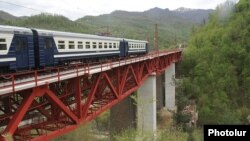Chinese investors are ready to finance an ambitious $3 billion project to build a railway connecting Armenia to Iran that could be launched in 2016, according to the Armenian government.
The 470-kilometer railway, which would mainly pass through Armenian territory, has been planned by the two neighboring states ever since the late 1990s. The project was formally approved by the Armenian and Iranian governments in 2009. But it has yet to get off the drawing board mainly because of their failure to attract funding for the Armenian section of the strategic transport link.
Rasia FZE, a little-known investment company based in Dubai, was granted in 2012 a 50-year concession to build and manage the 305-kilometer section to be named the Southern Armenian Railway (SAR). Rasia in turn contracted the China Communications Construction Company (CCCC) group to conduct a feasibility study and recommend a cost-effective route for the railway.
Joseph Borkowski, the Rasia chairman, presented the final results of the study to Prime Minister Tigran Sarkisian at a meeting in Yerevan on Tuesday. According to Sarkisian’s press office, the CCCC estimates the total cost of railway construction at $3.2 billion, a sum equivalent to Armenia’s entire 2014 state budget.
“According to the submitted program, the construction work may start in 2016 and end in 2022,” the office said in a statement. It said Sarkisian stressed the need for drawing up a “roadmap” to the project’s implementation.
Sarkisian and Borkowski already discussed the CCCC’s findings when they met last September on the sidelines of an international economic forum held in the Chinese city of Dalian. A statement on that meeting released by Rasia said the government-controlled Chinese firm believes in the “strong economic viability and regional importance of the railway.”
“As the key missing link in the International North-South Transport Corridor, the Southern Armenia Railway will create the shortest transportation route from the ports of the Black Sea to the ports of the Persian Gulf,” said the statement. “The Southern Armenia Railway will establish a major commodities transit corridor between Europe and the Persian Gulf region, with conservative long-term traffic volume forecasts of 18.3 million tons per annum.”
The railway would mainly run through Armenia’s mountainous Syunik province bordering Iran. Hence the very high cost of construction, which has long raised doubts about its feasibility. “The railway will have 84 bridges spanning 19.6 kilometers and 60 tunnels of 102.3 kilometers, comprising 40 percent of the total project length,” Rasia said in September 2013.
Sarkisian’s office quoted Borkowski as saying on Tuesday that his Dubai-based company is already looking for international investors interested in the project. “It was pointed out that Chinese banks … have expressed readiness to finance 60 percent of the project,” it said without elaborating.
Armenian officials have previously referred to Russia as another potential source of funding. The Russian government and RZhD national rail company have not ruled out such possibility.
The issue was apparently on the agenda of September 2013 talks near Moscow between the Armenian and Russian presidents that were followed by the announcement of Armenia’s unexpected decision to join a Russian-led alliance of ex-Soviet statements. In a joint communique, they pledged “the continuation of joint efforts to realize infrastructure projects, including railway communication, as well as the construction of new logistical and communication routes.”
Still, the Russians have so far made no formal commitments on the Armenia-Iran rail link, which is also strongly supported by the Iranian government. The Iranian ambassador to Armenia, Mohammad Reisi, said earlier this month that the expensive project will feature large at the next meeting of an Armenian-Iranian intergovernmental commission on economic cooperation.
The 470-kilometer railway, which would mainly pass through Armenian territory, has been planned by the two neighboring states ever since the late 1990s. The project was formally approved by the Armenian and Iranian governments in 2009. But it has yet to get off the drawing board mainly because of their failure to attract funding for the Armenian section of the strategic transport link.
Rasia FZE, a little-known investment company based in Dubai, was granted in 2012 a 50-year concession to build and manage the 305-kilometer section to be named the Southern Armenian Railway (SAR). Rasia in turn contracted the China Communications Construction Company (CCCC) group to conduct a feasibility study and recommend a cost-effective route for the railway.
Joseph Borkowski, the Rasia chairman, presented the final results of the study to Prime Minister Tigran Sarkisian at a meeting in Yerevan on Tuesday. According to Sarkisian’s press office, the CCCC estimates the total cost of railway construction at $3.2 billion, a sum equivalent to Armenia’s entire 2014 state budget.
“According to the submitted program, the construction work may start in 2016 and end in 2022,” the office said in a statement. It said Sarkisian stressed the need for drawing up a “roadmap” to the project’s implementation.
Sarkisian and Borkowski already discussed the CCCC’s findings when they met last September on the sidelines of an international economic forum held in the Chinese city of Dalian. A statement on that meeting released by Rasia said the government-controlled Chinese firm believes in the “strong economic viability and regional importance of the railway.”
“As the key missing link in the International North-South Transport Corridor, the Southern Armenia Railway will create the shortest transportation route from the ports of the Black Sea to the ports of the Persian Gulf,” said the statement. “The Southern Armenia Railway will establish a major commodities transit corridor between Europe and the Persian Gulf region, with conservative long-term traffic volume forecasts of 18.3 million tons per annum.”
The railway would mainly run through Armenia’s mountainous Syunik province bordering Iran. Hence the very high cost of construction, which has long raised doubts about its feasibility. “The railway will have 84 bridges spanning 19.6 kilometers and 60 tunnels of 102.3 kilometers, comprising 40 percent of the total project length,” Rasia said in September 2013.
Sarkisian’s office quoted Borkowski as saying on Tuesday that his Dubai-based company is already looking for international investors interested in the project. “It was pointed out that Chinese banks … have expressed readiness to finance 60 percent of the project,” it said without elaborating.
Armenian officials have previously referred to Russia as another potential source of funding. The Russian government and RZhD national rail company have not ruled out such possibility.
The issue was apparently on the agenda of September 2013 talks near Moscow between the Armenian and Russian presidents that were followed by the announcement of Armenia’s unexpected decision to join a Russian-led alliance of ex-Soviet statements. In a joint communique, they pledged “the continuation of joint efforts to realize infrastructure projects, including railway communication, as well as the construction of new logistical and communication routes.”
Still, the Russians have so far made no formal commitments on the Armenia-Iran rail link, which is also strongly supported by the Iranian government. The Iranian ambassador to Armenia, Mohammad Reisi, said earlier this month that the expensive project will feature large at the next meeting of an Armenian-Iranian intergovernmental commission on economic cooperation.





